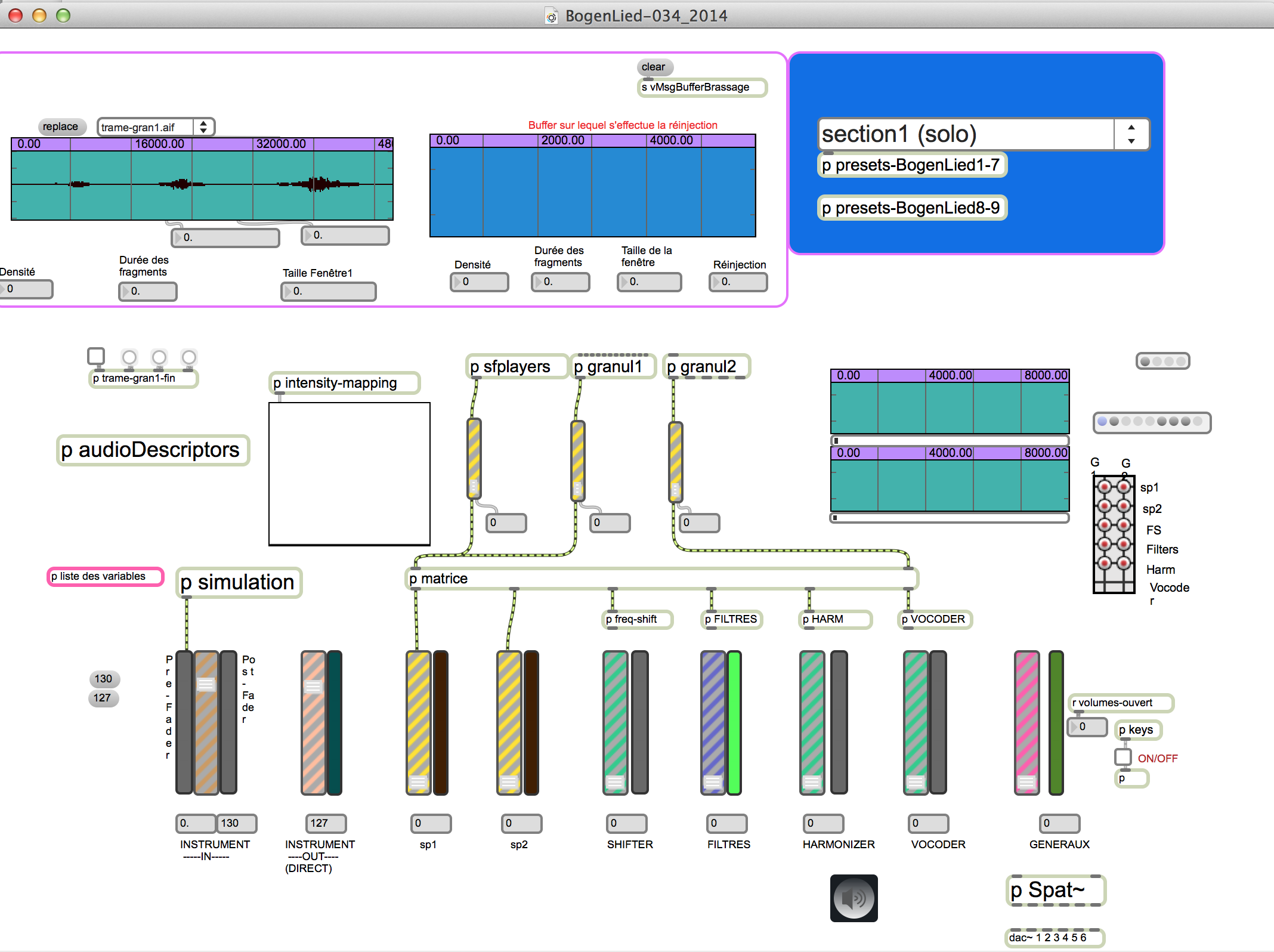Table of contents
Documentation date: 29 mai 2014
Version state
Valid
Validation date: 3 mai 2018
Version documentalist
Version realisation
- Serge Lemouton (Computer Music Designer)
Version length
11 mn 40 sUpgrade Motivation
Get rid of the augmented bow to simplify the piece setup.
Gesture detection is replaced by audio descriptors.
Comment
Version for one Macintosh and with an ordinary bow (no sensor required)
Other version(s)
Detailed staff
- soliste : violon [augmenté]
Electronic equipment list
Computer Music Equipment
-
1 MacBook Pro - Apple Laptops
(Apple)
-
1 Max 6 - Max
(Cycling74)
-
2 Hammerfall Multiface - Sound Board
(RME)
-
1 BCF 2000 - MIDI Mixer
(Behringer)
Audio Equipment
-
1 DPA 4021 - Condenser Microphones
(DPA)
on the violin, for sound processing -
8 Loudspeaker - Loudspeakers
Work related information
Premiere
- 26 novembre 2005, France, Dijon, Parvis Saint Jean
Publisher :
- Jobert
Realisation
- Serge Lemouton
Work length
- 8 mn
Useful links on Brahms
- BogenLied pour violon augmenté et électronique (2005), 8mn
- Florence Baschet
| File | Author(s) | Comment | |
|---|---|---|---|
| Download [244,2 Mio] | Patch BogenLiedPatch | Serge Lemouton | Patch, libraries and sounds |
Instructions
Audio setup
Two microphones are required :
- one for sound processing on the violin body (called "Violin Mike")
- the other one, on stand, for simple sound amplification
Loudspeaker setup

Software installation
MaxMSP 6.1 on a MacBookPro under MacOs X 10.6 or above.
Initialization routine
on the Mac :
Set the File Preferences to the folders lib/ and snd/.
Open BogenLied-034_2014 on the Audio Mac.
Audio Patch presentation

The Max/MSP sound patch contains two granular synthesis modules and several effects. The first granulator is used to produce drones (pedal-notes) triggered by the bow strokes.
A separate drone is linked to each bowing styles: G, A, and E for détaché, martelé and spiccato, respectively.
The second granulator is used for real-time processing of the violin sound. The audio signal from the microphone is stored in a 5 second circular buffer~, and 100 to 200 ms grains are played back from this buffer.
The granular synthesis sound is processed through several standard effects: frequency-shifter, harmonizer, filter and vocoder. Different combinations and parameterizations of these effects are used in each section.
In the original version, some parameters were controlled in realtime by the gesture data, using Ircam extended bow ; in this version these parameters are controlled directly by the violin sound, using temporal audio descriptors related to the bowing techniques.
Performance notes
On the Max patch, you can select the current section with the menu or using the left and right arrow keys on the computer keyboard.
The musical form of BogenLied is a simple linear form divided into nine sections, alternatively with and without electronics.
In section II, IV and VI, the musical writing is focused on specific articulations of bow strokes: détaché, martelé, spiccato.
Each of these sections is associated to specific compositional materials, as well as to specific electronic sound processes.
In the two final sections, the choice of the electronic processes is driven by the recognition system.The electronic sound is then built as a combination of the electronic processes performed in section II, IV and VI.
In section VIII, the three bowing styles appear successively, along with their associated compositional material.
In the last section (IX), the performer plays hybrid bow strokes, which sequence appears as a series of “mutations” from one articulation to another one.
The last event in the list should be triggered on the violin last note.
© IRCAM

This documentation is licensed under a Creative Commons Attribution-NonCommercial-NoDerivatives 4.0 International License.
Program note
BogenLied (2005) est une pièce pour « violon augmenté » et électroacoustique en temps réel. Ce violon au nom particulier fait l’objet d’un développement de recherche à l’Ircam. Prototype unique, le violon augmenté contient une puce électronique pesant seulement quelques grammes et placée sur la hausse de l’archet du violoniste. Cette puce est capable de capter en temps réel au moment du concert, les phrasés gestuels que le soliste exécute avec son archet sur les cordes, et de transmettre ces informations à l’ordinateur placé au centre du dispositif électroacoustique.
Pourquoi le phrasé gestuel de l’instrumentiste est-il à ce point intéresssant ? je répondrai qu’il est l’outil qui élabore le son, celui qui façonne le timbre de l’objet sonore par de multiples qualités de célérité, d’énergie ou de position de l’archet sur la corde. Ce qui m’intéresse donc en tant que compositeur, c’est de placer mon écoute dans ce lieu réservé de l’instrumentiste, de capter ses phrasés gestuels et de créer à partir de ces données, un système interactif d’un genre tout à fait nouveau entre l’ordinateur et le musicien. Car ici, l’espace sonore électroacoustique est entièrement piloté par le coup d’archet du violoniste.
BogenLied est la première pièce écrite pour violon augmenté, commande de l’Association Cumulus, créée en concert en co-réalisation avec l’Ircam par Anne Mercier, violon soliste de l’ensemble L’Itinéraire. Réalisation informatique musicale Ircam : Serge Lemouton. Technologie violon augmenté Ircam : Nicolas Rasamimanana, Frédéric Bevilacqua, Emmanuel Fléty.
Florence Baschet.
Version documentation creation date: 29 mai 2014 11:09, update date: 6 mai 2021 15:09